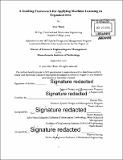A guiding framework for applying machine learning in organizations
Author(s)
Tham, Alan (Alan An Liang)
DownloadFull printable version (16.61Mb)
Other Contributors
Massachusetts Institute of Technology. Engineering Systems Division.
Advisor
Patrick Hale.
Terms of use
Metadata
Show full item recordAbstract
Machine Learning (ML) is an emerging business capability that have transformed many organizations by enabling them to learn from past data and helping them predict or make decisions on unknown future events. While ML is no longer the preserve of large IT companies, there are abundant opportunities for mid-sized organizations who do not have the resources of the larger IT companies to exploit their data through ML so as to gain deeper insights. This thesis outlines these opportunities and provide guidance for the adoption of ML by these organizations. This thesis examines available literature on current state of adoption of ML by organizations which highlight the gaps that motivate the thesis in providing a guiding framework for applying ML. To achieve this, the thesis provides the practitioner with an overview of ML from both technology and business perspectives that are integrated from multiple sources, categorized for ease of reference and communicated at the decision making level without delving into the mathematics behind ML. The thesis thereafter proposes the ML Integration framework for the System Architect to review the enterprise model, identify opportunities, evaluate technology adoption and architect the ML System. In this framework, system architecting methodologies as well as Object-Process Diagrams are used to illustrate the concepts and the architecture. The ML Integration framework is subsequently applied in the context of a hypothetical mid-sized hospital to illustrate how an architect would go about utilizing this framework. Future work is needed to validate the ML Integration framework, as well as improve the overview of ML specific to application domains such as recommender systems and speech/image recognition.
Description
Thesis: S.M. in Engineering and Management, Massachusetts Institute of Technology, School of Engineering, System Design and Management Program, Engineering and Management Program, 2016. Cataloged from PDF version of thesis. Includes bibliographical references (pages 93-97).
Date issued
2016Department
Massachusetts Institute of Technology. Engineering and Management Program; System Design and Management Program.Publisher
Massachusetts Institute of Technology
Keywords
Engineering and Management Program., System Design and Management Program., Engineering Systems Division.